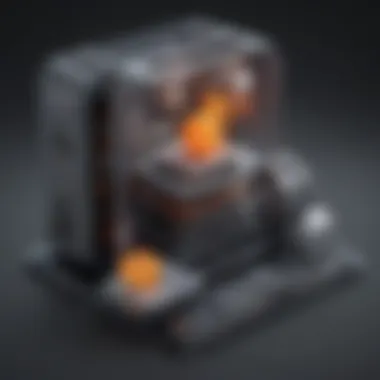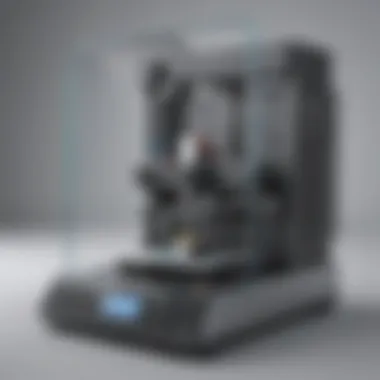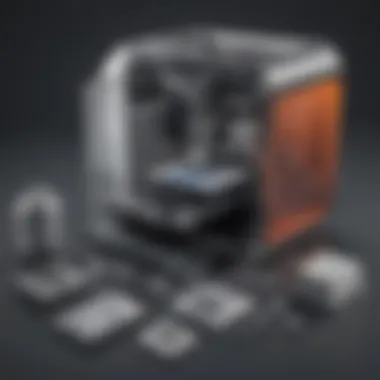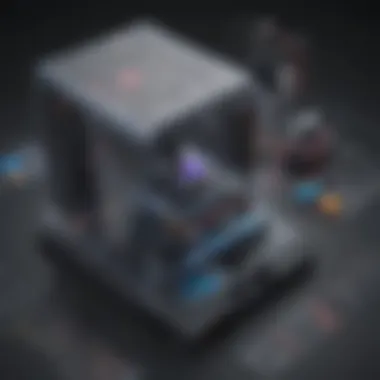Unveiling the Intriguing Universe of 3D Plastic Printer Machines


Tech Trend Analysis
The realm of 3D plastic printer machines presents a captivating landscape of innovation and technological advancement. At the heart of the current trend lies the convergence of precision engineering and creative design, catering to a burgeoning market of tech enthusiasts and industry professionals. This intrinsic fusion has profound implications for consumers, offering bespoke solutions for prototyping, manufacturing, and artistic expression. Looking ahead, the future holds promising developments, with enhanced speed, accuracy, and material diversity poised to revolutionize the 3D printing landscape.
Product Reviews
Unveiling the intricacies of 3D plastic printer machines reveals a symphony of cutting-edge features and specifications. From high-resolution printing capabilities to versatile material compatibility, these machines demonstrate unparalleled performance across varied applications. A detailed performance analysis highlights their exceptional accuracy, speed, and durability, positioning them as a stalwart in the realm of additive manufacturing. However, like any technology, there exist pros and cons - the precision of output versus the time investment, the versatility of materials against cost considerations. In light of these nuances, a well-informed recommendation guide aids in navigating the diverse options available, tailored to specific needs and preferences.
How-To Guides
Embarking on a journey into the world of 3D plastic printer machines necessitates a fundamental grasp of its operation and potential. An introduction elucidates the basic principles governing 3D printing technology, offering insights into filament types, printing processes, and software integration. Delving deeper, step-by-step instructions unravel the intricate dance of hardware setup, file preparation, and print execution, laying a solid foundation for novices and seasoned craftsmen alike. Beneath the surface, a treasure trove of tips and tricks awaits discovery, enhancing print quality, optimizing efficiency, and unleashing creative ingenuity. Moreover, troubleshooting common challenges empowers users to resolve issues swiftly, ensuring a seamless printing experience with minimal downtime.
Industry Updates
Amidst the rapidly evolving landscape of the tech industry, 3D plastic printer machines have carved a prominent niche, driving innovation and redefining traditional manufacturing paradigms. Recent developments underscore a relentless pursuit of excellence, with advances in speed, quality, and affordability reshaping the competitive dynamics. Concurrently, a nuanced analysis of market trends unveils a tapestry of opportunities and challenges, as businesses and consumers navigate the complex terrain of additive manufacturing. This symbiosis between technology and industry underscores the transformative impact of 3D printing, heralding a new era of customization, efficiency, and sustainability.
Introduction to 3D Plastic Printer Machines
In this comprehensive guide, we delve into the realm of 3D plastic printer machines, exploring their technology, applications, benefits, and impact on various industries. The significance of understanding 3D plastic printer machines lies in their revolutionary capabilities to transform manufacturing processes, enabling enhanced customization, cost-efficiency, and rapid prototyping. As we embark on this exploration, it becomes apparent that these machines are not mere tools but gateways to a future where innovation knows no bounds.
Understanding 3D Printing Technology
The Evolution of 3D Printing
The evolution of 3D printing marks a pivotal shift in the manufacturing landscape, revolutionizing how objects are conceptualized and created. This section delves into the historical development of 3D printing, tracing its roots to its current state of cutting-edge technology. An in-depth analysis of the evolution of 3D printing sheds light on the advancements that have shaped this field, showcasing its evolution from a niche concept to a mainstream technological marvel. By understanding this evolution, we gain insight into the progressive nature of 3D printing and its continuous drive towards innovation.
Key Components of 3D Printers
Examining the key components of 3D printers reveals the intricate mechanisms that enable these machines to bring digital designs to life. From extruders to build platforms, each component plays a vital role in the 3D printing process, influencing the quality and precision of the final output. Understanding these components equips us with the knowledge to optimize the printing process, ensuring efficiency and accuracy in every print. By delving into the key components of 3D printers, we unravel the complexities that underpin this technology, setting the stage for a comprehensive exploration of its capabilities.
Types of 3D Printing Processes
Diving into the various types of 3D printing processes offers a glimpse into the diverse methodologies that power additive manufacturing. From Fused Deposition Modeling (FDM) to Stereolithography (SLA), each process exhibits unique characteristics that cater to specific design requirements and material capabilities. By elucidating the nuances of each printing process, we uncover the breadth of possibilities that 3D printing offers, opening new avenues for innovation and creativity. Understanding the types of 3D printing processes allows us to appreciate the versatility of this technology and its potential to transform industries.


Applications of 3D Printing in Various Industries
Automotive
The automotive industry represents a key sector where 3D printing technology has made significant inroads, revolutionizing prototyping, custom part production, and even vehicle design. This section explores how 3D printing has streamlined the manufacturing processes in the automotive sector, enabling faster production cycles and cost-effective solutions. By examining the applications of 3D printing in automotive innovation, we witness a paradigm shift towards agile production methods and sustainable design practices that define the future of mobility.
Healthcare
In the realm of healthcare, 3D printing has emerged as a game-changer, enabling personalized medical devices, prosthetics, and even surgical models. This segment sheds light on the impact of 3D printing in healthcare, showcasing its ability to deliver bespoke solutions tailored to individual patient needs. By exploring the applications of 3D printing in healthcare, we discover a realm where technology intersects with humanity, offering novel approaches to patient care and medical advancements.
Architecture and Construction
Architecture and construction stand at the forefront of innovation, leveraging 3D printing technology to reimagine traditional building practices and structural design. This segment delves into how 3D printing is reshaping the architectural landscape, facilitating intricate geometries, sustainable construction materials, and on-site fabrication. By delving into the applications of 3D printing in architecture and construction, we witness a convergence of creativity and functionality that paves the way for sustainable urban development and dynamic built environments.
Benefits of Using 3D Plastic Printer Machines
Cost-Efficiency
The cost-efficiency of 3D plastic printer machines offers a competitive edge to manufacturers, reducing production costs, minimizing material wastage, and optimizing resource utilization. This segment explores how 3D printing translates into cost savings across various industries, showcasing its ability to streamline manufacturing processes and enhance operational efficiency. By elucidating the cost-efficiency of 3D plastic printer machines, we uncover a sustainable approach to production that aligns economic viability with environmental responsibility.
Customization and Personalization
Personalization lies at the core of 3D printing, empowering designers and consumers to create bespoke products tailored to specific preferences and requirements. This section delves into how customization and personalization enhance the user experience, fostering creative expression and product differentiation. By highlighting the flexibility offered by 3D plastic printer machines, we unlock a realm of endless possibilities where individuality meets innovation, paving the way for consumer-centric manufacturing practice.
Rapid Prototyping
Rapid prototyping heralds a new era of product development, enabling swift iteration, design validation, and concept realization. This segment delves into the benefits of rapid prototyping with 3D plastic printer machines, showcasing how expedited design cycles and quick turnaround times foster innovation and agility. By elucidating the role of rapid prototyping in accelerating the product development process, we embrace a dynamic approach to innovation that prioritizes speed, precision, and creativity.
Exploration of Advanced Features in 3D Plastic Printers
In this segment, we delve into the intricate world of advanced features in 3D plastic printers, showcasing the evolution of technology within this realm. It is imperative to grasp the significance of these advancements as they pave the way for enhanced functionality and diverse applications. By understanding the specific elements, benefits, and considerations regarding the exploration of advanced features in 3D plastic printers, we can appreciate the full scope of capabilities that these machines offer.
Multi-Material and Multi-Color Printing


Innovations in Material Compatibility
The innovations in material compatibility represent a pivotal aspect of 3D printing technology evolution. This feature enables seamless integration of various materials, expanding the horizons of creativity and functionality. The key characteristic lies in the versatility it offers, empowering users to experiment with a wide range of materials to achieve desired outcomes. Innovations in material compatibility are a popular choice for enthusiasts seeking to push the boundaries of traditional 3D printing, offering a reliable and efficient option. The unique feature of material compatibility lies in its adaptability to different project requirements, catering to diverse needs effectively.
Color Blending Techniques
Color blending techniques play a crucial role in enhancing the aesthetic appeal of 3D printed objects. By blending different colors seamlessly, this technique adds a layer of complexity and artistic flair to creations. The key characteristic is the ability to create gradient effects and intricate color patterns, elevating the visual impact of printed objects significantly. Color blending techniques are a beneficial choice for those looking to add a personalized touch to their projects, as it allows for customization and uniqueness. The unique feature of color blending lies in its capacity to transform ordinary prints into vibrant and visually stunning masterpieces.
Large-Scale Printing Capabilities
Industrial Applications
Large-scale printing capabilities cater to industrial applications where size and precision are paramount. This feature ensures that industries can create prototypes and functional parts on a grand scale with high levels of accuracy. The key characteristic of industrial applications is the ability to produce large components efficiently, reducing production time and costs significantly. Industrial applications are a popular choice for companies requiring rapid prototyping and manufacturing of sizable objects. The unique feature lies in the scalability and precision offered, addressing the demands of industrial sectors effectively.
Architectural Prototyping
Architectural prototyping serves as a critical component in the construction and design fields, allowing professionals to visualize and materialize their concepts. This feature enables architects and designers to create intricate scale models and detailed prototypes with ease. The key characteristic of architectural prototyping is its accuracy and attention to detail, ensuring that designs are translated seamlessly from concept to physical form. Architectural prototyping is a beneficial choice for architectural firms and construction companies seeking to streamline their design processes. The unique feature lies in its ability to revolutionize the traditional architectural modeling techniques, optimizing time and resources effectively.
Automation and Smart Features
AI Integration
AI integration marks a significant advancement in the realm of 3D printing, where artificial intelligence enhances the overall printing process. This feature optimizes workflow, enhances precision, and enables autonomous decision-making during printing jobs. The key characteristic of AI integration is its adaptability to various printing scenarios, ensuring optimized outcomes based on intricate algorithms and data analysis. AI integration is a popular choice for professionals aiming for increased efficiency and accuracy in their printing endeavors. The unique feature of AI integration lies in its capacity to learn and adapt, constantly improving printing quality and speed.
IoT Connectivity
The integration of Io T connectivity revolutionizes how 3D printers operate and communicate within smart ecosystems. This feature allows seamless connectivity to other devices and networks, enabling remote monitoring and control. The key characteristic of IoT connectivity is the enhanced accessibility and convenience it brings to the printing process, enabling users to manage prints remotely. IoT connectivity is a beneficial choice for tech-savvy users looking to streamline their workflow and monitor printing progress effectively. The unique feature lies in the interconnectedness it fosters, creating a cohesive printing environment that maximizes efficiency and productivity.
Impact of 3D Printing on Industries and Society
In this section, we delve into the critical topic of the impact of 3D printing on industries and society, showcasing its transformative effects. 3D printing has revolutionized manufacturing processes across various sectors, offering numerous benefits and considerations for industries and society alike. The integration of 3D printing technology has led to increased efficiency, cost-effectiveness, and innovation in production methods. Moreover, its adaptability to diverse applications has significantly influenced industrial and societal advancements, making it a pivotal subject in today's tech-driven world.
Revolutionizing Manufacturing Processes


Just-In-Time Production:
The concept of Just-In-Time (JIT) production emphasizes efficiency and minimal inventory levels by delivering components or products exactly when they are needed in the manufacturing process. JIT production optimizes resource utilization, reduces waste, and enhances supply chain management. This system streamlines the production process, allowing companies to respond swiftly to market demands while minimizing excess inventory costs. JIT production's key characteristics lie in its strategic inventory management and real-time responsiveness, making it an increasingly popular choice for industries seeking lean and agile manufacturing solutions. However, JIT production also poses challenges such as logistical precision requirements and potential supply chain disruptions.
Mass Customization:
Mass customization involves tailoring products or services to meet individual customer preferences on a large scale. This approach combines the efficiency of mass production with the personalization of bespoke manufacturing, offering consumers unique and customized products. Mass customization enhances customer engagement, strengthens brand loyalty, and drives innovation in product development. The key feature of mass customization lies in its ability to offer diversity and flexibility in product offerings without compromising production efficiency. While advantageous for fulfilling diverse consumer needs, mass customization demands sophisticated production processes, robust data management, and dynamic supply chain capabilities.
Environmental Sustainability
Reduced Material Waste:
Reducing material waste is a critical aspect of sustainable manufacturing practices associated with 3D printing technology. By precisely allocating materials during the printing process, 3D printers minimize excess waste compared to traditional subtractive manufacturing methods. This eco-friendly approach reduces environmental impact, conserves resources, and promotes sustainability in industrial operations. The key characteristic of reduced material waste in 3D printing emphasizes efficient material utilization, leading to cost savings and environmental stewardship. However, challenges such as material selection and recycling complexities may hinder the full implementation of reduced material waste practices.
Reusable Filaments:
Incorporating reusable filaments in 3D printing contributes significantly to environmental sustainability by promoting material reusability and waste reduction. Reusable filaments allow for the recycling and repurposing of printed objects, reducing material consumption and waste generation. This approach aligns with the circular economy model by extending the lifespan of materials and minimizing environmental impact. The unique feature of reusable filaments lies in their recyclability and versatility, offering long-term cost benefits and environmental preservation. Despite these advantages, limitations such as filament quality variations and compatibility issues may affect the widespread adoption of reusable filaments in 3D printing processes.
Challenges and Future Trends
Regulatory Hurdles:
Navigating regulatory frameworks and compliance requirements poses significant challenges for the integration of 3D printing technologies in existing industries. Regulatory hurdles encompass safety standards, intellectual property rights, and quality control measures that influence the utilization of 3D printing for commercial applications. Establishing clear regulations and industry standards is crucial to ensuring product quality, consumer safety, and ethical use of 3D printing technology. The key characteristic of regulatory hurdles underscores the importance of legal compliance and ethical considerations in implementing 3D printing solutions. While addressing regulatory challenges enhances industry credibility and consumer trust, inadequate regulations may impede technological innovation and market growth.
Bioprinting and Organ Manufacturing:
The emerging field of bioprinting and organ manufacturing explores the revolutionary potential of 3D printing in healthcare and biomedical engineering. Bioprinting technologies enable the precise deposition of biological materials to fabricate tissues, organs, and medical implants. This cutting-edge approach holds promise in regenerative medicine, personalized healthcare, and transplant surgeries, offering innovative solutions to address organ shortages and medical challenges. The unique feature of bioprinting lies in its ability to recreate complex biological structures with high precision and customization, paving the way for advanced medical treatments and therapies. Despite its transformative impact on healthcare, bioprinting faces ethical dilemmas, regulatory complexities, and technical limitations that impact its widespread adoption and scalability.
Conclusion: Embracing the Potential of 3D Plastic Printer Machines
In this conclusive section of the article, we delve into the pivotal importance of embracing the potential that 3D plastic printer machines offer. By understanding how these innovative devices revolutionize traditional manufacturing processes, we can forecast the remarkable advancements awaiting various industries. Exploring the depths of 3D plastic printer machines uncovers a world of endless possibilities and efficiencies in production. This section aims to encapsulate the profound impact that these machines have on shaping the future landscape of manufacturing and design.
Innovative Applications and Boundless Opportunities
Driving Technological Advancements
Driving Technological Advancements play a critical role in propelling the evolution of 3D plastic printer machines. These advancements lead to enhanced capabilities, improved efficiency, and expanded horizons for creativity. The key characteristic of Driving Technological Advancements lies in its continuous push towards pioneering new functionalities and features within 3D printing technology. By embracing these advancements, industries can achieve unparalleled precision and intricacy in their printed designs. However, integrating these advancements may require significant expertise and investment, balancing the advantages of cutting-edge technology with the associated costs and complexities.
Empowering Creativity
Empowering Creativity stands at the core of leveraging the full potential of 3D plastic printer machines. This aspect fosters a culture of innovation and experimentation, allowing designers and engineers to push the boundaries of what is possible. The key characteristic of Empowering Creativity is its ability to democratize the design process, enabling individuals from diverse backgrounds to translate their ideas into tangible creations. By empowering creativity, 3D printing technology opens up avenues for unconventional solutions and breakthrough designs. Nonetheless, navigating the realm of creativity requires a balance between imaginative exploration and practical feasibility, ensuring that innovative concepts translate into viable applications within this technological domain.



